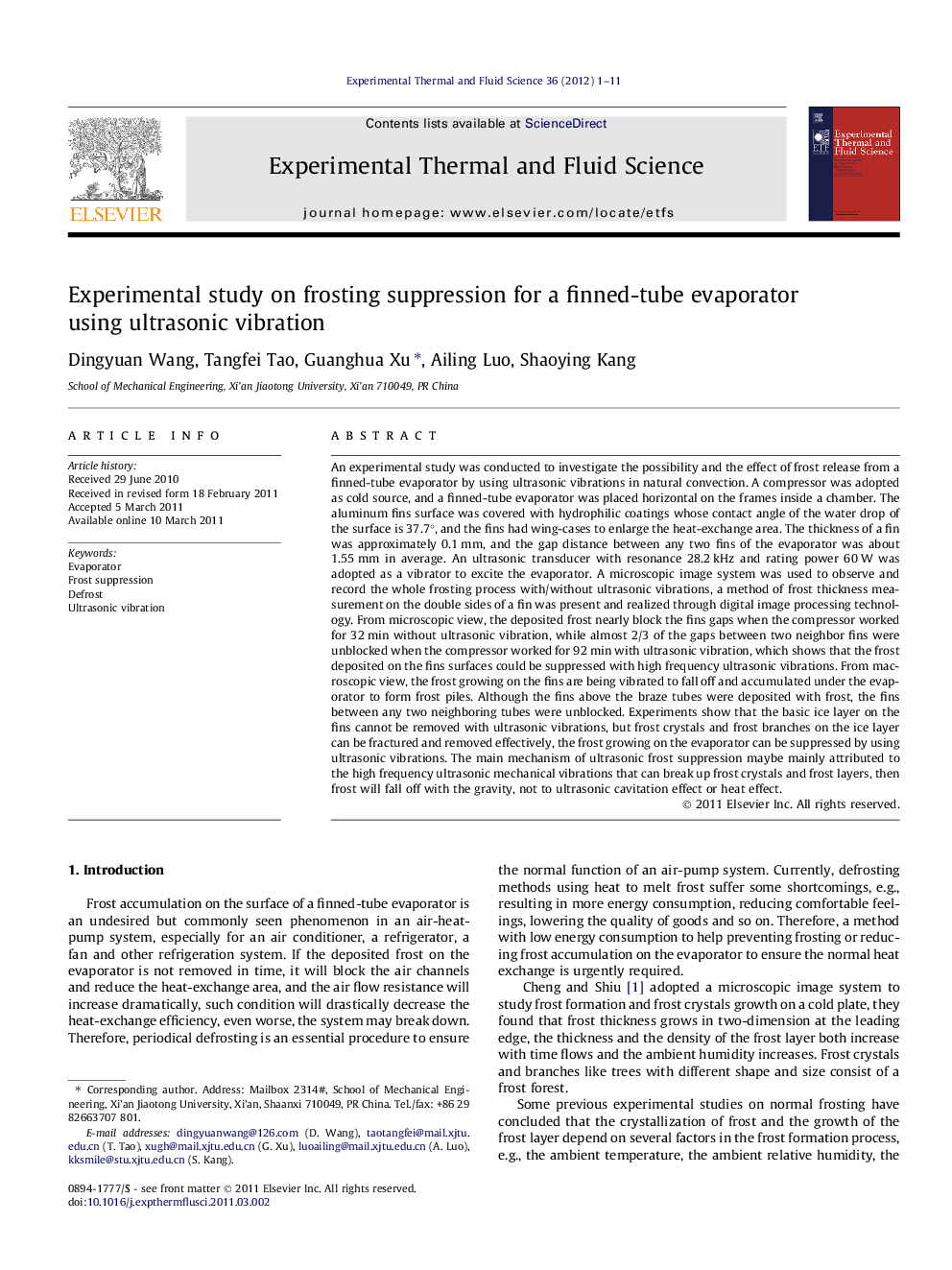| کد مقاله | کد نشریه | سال انتشار | مقاله انگلیسی | نسخه تمام متن |
|---|---|---|---|---|
| 651823 | 1457440 | 2012 | 11 صفحه PDF | دانلود رایگان |

An experimental study was conducted to investigate the possibility and the effect of frost release from a finned-tube evaporator by using ultrasonic vibrations in natural convection. A compressor was adopted as cold source, and a finned-tube evaporator was placed horizontal on the frames inside a chamber. The aluminum fins surface was covered with hydrophilic coatings whose contact angle of the water drop of the surface is 37.7°, and the fins had wing-cases to enlarge the heat-exchange area. The thickness of a fin was approximately 0.1 mm, and the gap distance between any two fins of the evaporator was about 1.55 mm in average. An ultrasonic transducer with resonance 28.2 kHz and rating power 60 W was adopted as a vibrator to excite the evaporator. A microscopic image system was used to observe and record the whole frosting process with/without ultrasonic vibrations, a method of frost thickness measurement on the double sides of a fin was present and realized through digital image processing technology. From microscopic view, the deposited frost nearly block the fins gaps when the compressor worked for 32 min without ultrasonic vibration, while almost 2/3 of the gaps between two neighbor fins were unblocked when the compressor worked for 92 min with ultrasonic vibration, which shows that the frost deposited on the fins surfaces could be suppressed with high frequency ultrasonic vibrations. From macroscopic view, the frost growing on the fins are being vibrated to fall off and accumulated under the evaporator to form frost piles. Although the fins above the braze tubes were deposited with frost, the fins between any two neighboring tubes were unblocked. Experiments show that the basic ice layer on the fins cannot be removed with ultrasonic vibrations, but frost crystals and frost branches on the ice layer can be fractured and removed effectively, the frost growing on the evaporator can be suppressed by using ultrasonic vibrations. The main mechanism of ultrasonic frost suppression maybe mainly attributed to the high frequency ultrasonic mechanical vibrations that can break up frost crystals and frost layers, then frost will fall off with the gravity, not to ultrasonic cavitation effect or heat effect.
► An experimental study has been conducted to prove the possibility and the effect of frost release from a finned-tube evaporator with hydrophilic coatings by using ultrasonic vibrations in normal convection.
► The phenomenon of the fracture of frost crystals and frost branches growing on the double sides of fins can be observed from microscopic view by using a microscopic image system in normal convection.
► The frost release from fins will be accumulated under the evaporator, however, ultrasonic vibrations can not ensure completely no frost deposited on the surface of the evaporator.
► A mechanical structure for transferring ultrasonic vibrations is very important, and the working mode of ultrasonic vibrations should be studied to improve the defrosting effect.
► The amplitude of vibration on the fins is very small, but the vibration frequency is high that corresponding to the vibration frequency of a transducer. The vibration amplitude can influence the effect of defrosting.
► Some other methods should work in with ultrasonic vibration to improve the effect of ultrasonic frost suppression, and to eliminate the influence of vibration nodes exist on the evaporator.
Journal: Experimental Thermal and Fluid Science - Volume 36, January 2012, Pages 1–11